The Beacon of Boyle Heights
Distrito Catorce offers a safe space by and for Boyle Heights residents amidst growing gentrification in East Los Angeles.
By Sara Kahn
Distrito Catorce offers a safe space by and for Boyle Heights residents amidst growing gentrification in East Los Angeles.
By Sara Kahn
Guillermo Pinon stands proudly behind the bar at Distrito Catorce, a bustling restaurant he built from scratch. “Our community understands the power of keeping our local economy strong and reinvesting in it,” he says, adding, “It’s particularly the reason why I’m here, too, because I wanted to reinvest in the community that gave us a lot and gave us this opportunity.”
Boyle Heights, along with much of East Los Angeles, has been the target of gentrification, a process that prioritizes building new, expensive developments that push residents out of their neighborhoods by raising the cost of housing. Distrito Catorce is a safe haven in the wake of gentrification, providing community, ambience, and good food to members of the Boyle Heights community. It is truly a place by and for Boyle Heights residents.
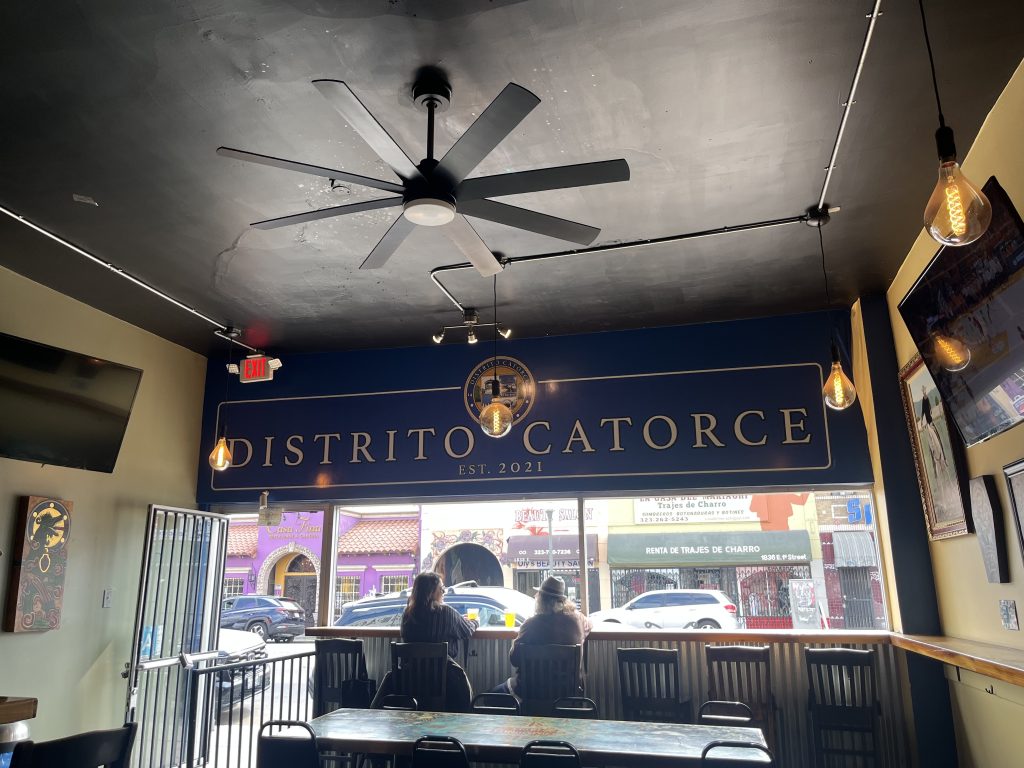
The restaurant sits on busy 1st Street, smack-dab in the middle of Boyle Heights. Next door is a small taco shop, from which patrons will sometimes bring their food for a seat and a beer. The restaurant has only been around since 2021, but it has provided togetherness, quality food, and a relaxed atmosphere to the area for the past four years.
Pinon grew up in El Sereno, mere miles from Boyle Heights. He knows the people, he knows the area, and he has made it his life’s work to be a force for good. He brings his cultural background of being Mexican-American into everything he does.
Having entered the world of entrepreneurship at age 18 and owning his first set of apartments at 21, Pinon is no stranger to what it takes to be successful in business. He has long served his community, sitting on the board of the Boyle Heights Chamber of Commerce and getting involved in multiple charitable projects. However, Distrito Catorce was a different kind of undertaking for him. The restaurant, which boasts a large open window looking out onto the street and bringing sunlight in, is in a space where a bar used to be. The windows of the bar were black, says Pinon, hiding the interior from the outside. The large window in Distrito Catorce is in stark juxtaposition to that energy. When the owner of the bar approached Pinon and offered him the real estate, he wanted to use that opportunity to make a change to the space.
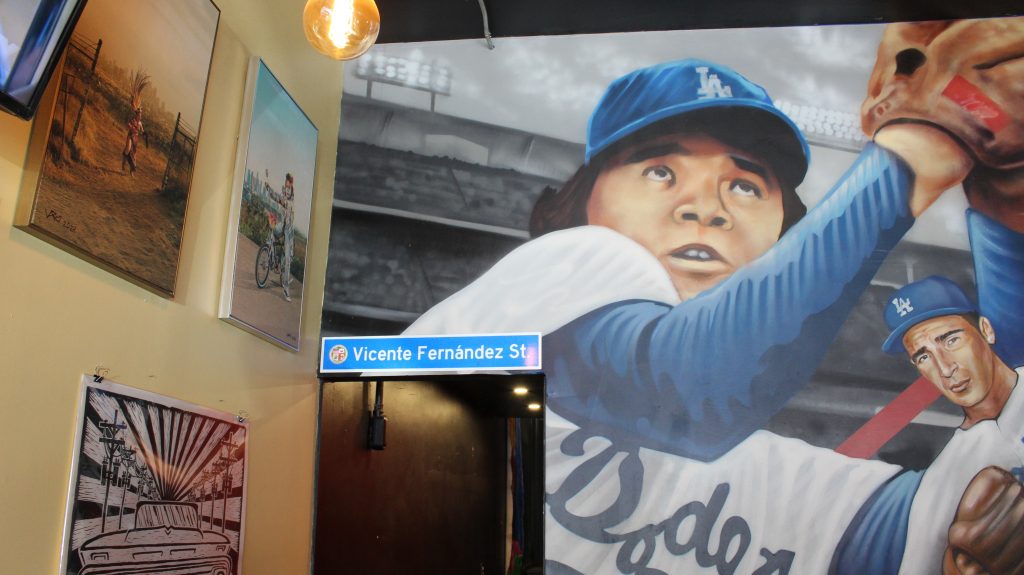
“Distrito was basically opened as…a safe space for our community to come and kind of enjoy each other. And it gives me a platform to be able to do all the things that I love, to give back to the community, work within the community. That’s what this space has done for me personally,” he said. “It’s basically given me a voice, to be able to say, hey, this is what I’m doing. This is what I am. It’s an awesome stage, and people pay attention.”
Pinon’s commitment to community building runs deep. He serves as the president of the Vezbi Foundation, a non-profit organization dedicated to using innovation to drive community impact. As stated on the website, “Through targeted grants, collaborative projects, and local investments, we support initiatives that address core social needs, from health and education to economic empowerment and sustainable development.” One of his primary philanthropic pursuits is working with an orphanage in Tijuana. Every year, he and the Distrito Catorce chef, Jonathan Perez, host a dinner to raise funds for the orphanage.
“I wear a whole bunch of other different hats, and especially when it comes down to my foundation, we do a lot of work with the immigrant community,” he says. “We’re building a lot of things. So I do a lot of work in Guadalajara. I travel to Mexico City a lot.”
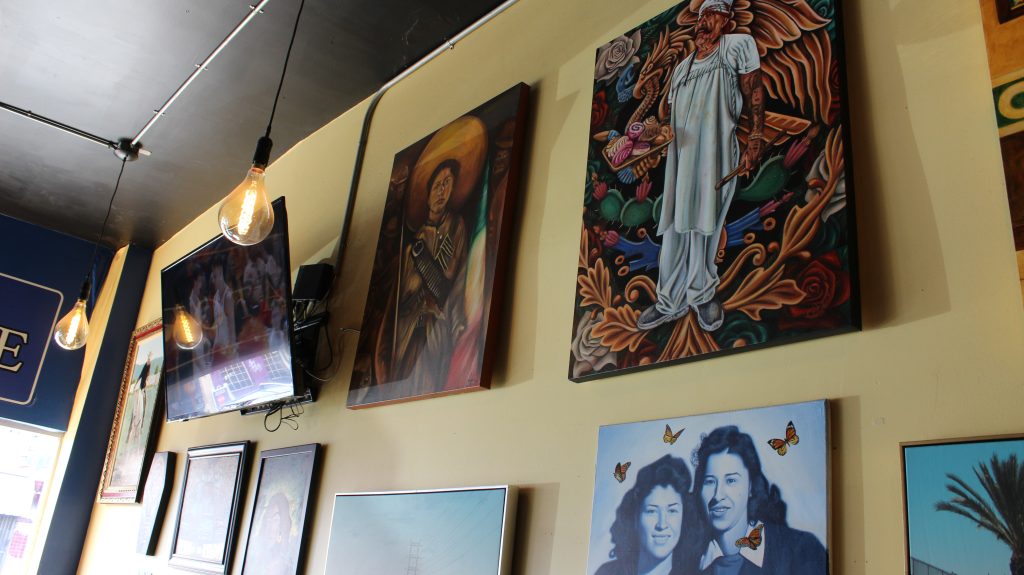
When Pinon was asked why he chose to open a restaurant, he replied without hesitation, stating, “Food is my love language. I love making sure you know that we do things through food because you get to sit down and break bread with people and have a conversation. There’s a lot of beauty in sharing meals with people.”
“There’s amazing food there. We listen to great music here. There’s a lot that goes on that gets involved, and that all comes from my experience of being involved in the community. I love doing community work.”
His commitment to his Mexican and Angeleno heritage can be felt in every aspect of the restaurant. On the restaurant’s side wall lies a small gallery with art created by Boyle Heights community-based artists. The art is constantly being switched out, and the wall is booked up for the next fourteen months. On the back wall is a mural dedicated to the Los Angeles Dodgers. Pinon hopes to commission more art from local artists to fill up the space even further.
“What I’m doing here is including the beauty and all the talent that’s in the community. Because of my experience with all that, I’m able to bring it into a space where I can share, basically, my life story with everybody else. That’s why, if you come in here, there’s a lot of culture,” he says, looking around with a smile. “There’s amazing food there. We listen to great music here. There’s a lot that goes on that gets involved, and that all comes from my experience of being involved in the community. I love doing community work.”
Distrito Catorce’s menu was created with love and culture in mind by the restaurant’s chef and Pinon’s business partner, Perez. A product of Guatemalan immigrants who grew up in Long Beach, California, Perez has worked his way up in the culinary world. He began his career in the fast food industry before getting his associate’s degree in culinary arts. From there, Perez worked in a variety of kitchens, from the Four Seasons to USC, where he helped craft the menus for various restaurants on campus.
He grew up around Mexican cuisine and quickly fell in love with its distinct flavors. “When I was a lot younger, all the neighborhood kids and my friend’s parents and all that, when I would get invited to their house, it was very straightforward Mexican food,” he says. “ I fell in love with the food [and] the canvas behind Mexican cuisine and the tradition behind it as well.”
With Distrito Catorce, Perez blends his training in classical European cuisine with a keen understanding of the cultural landscape of Boyle Heights. “The way I approach[ed] this new menu that we have here, it just went based on what Boyle Heights and the community has to offer,” he explained. He seeks to add a creative twist to the neighborhood’s cuisine while still being highly conscious and respectful of its unique traditions.
Distrito Catorce respects the growing appreciation of modern Mexican cuisine while simultaneously seeking to take into account local traditions. As Professor of Latinx Food Studies at USC Sarah Portnoy points out, “In the past 15 years or so, there’s been a new appreciation and respect for Mexican cuisine, that it can be a $20, $30 dish, it doesn’t have to be a dollar taco. It has garnered a higher respect.”
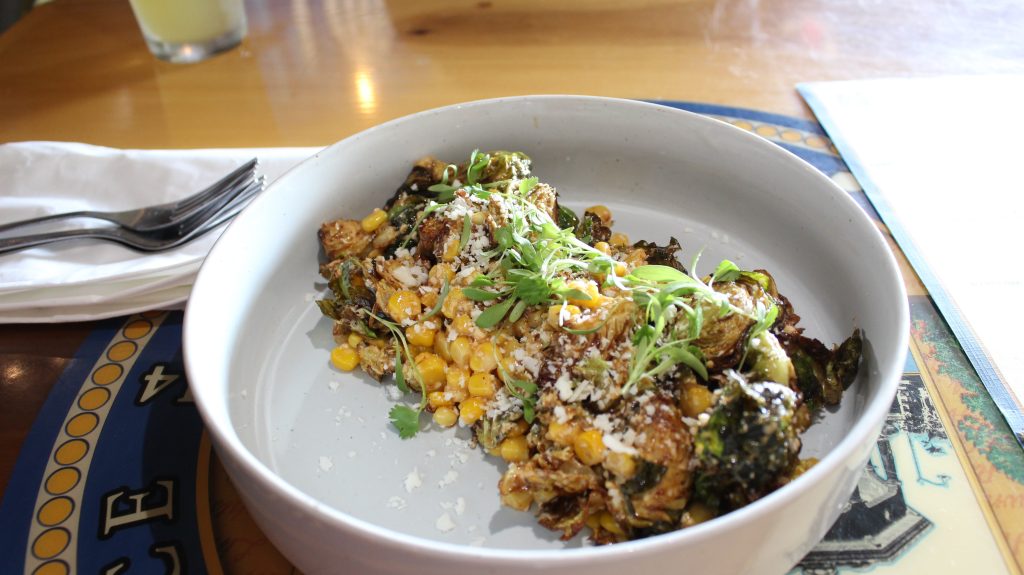
“We want to showcase that our food can be elevated, and it’s elevated for us, by us and for our community,” said Pinon. “And we were very strategic on how we did it, too. Everything is kind of a Mexican-based flavor. But then we do different aspects of it. What we did, from a financial standpoint, was we made it so our plates are kind of shareable.”
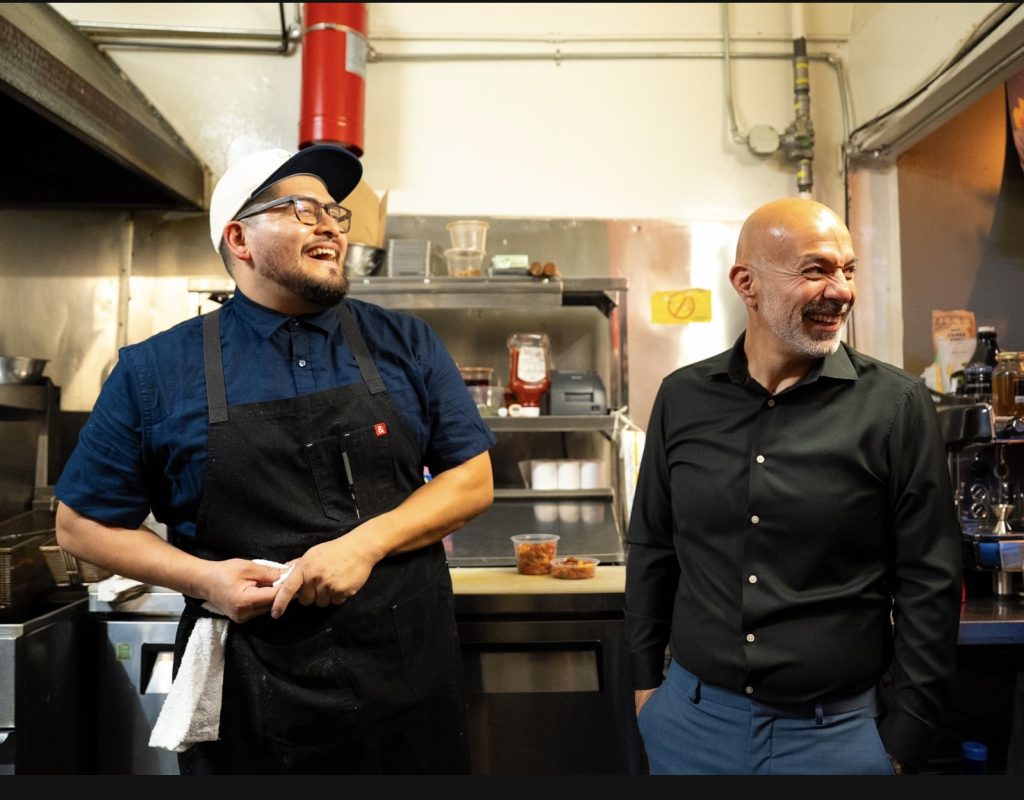
Distrito Catorce also has a lively social media presence, highlighting its food, events, and the people behind it all. It utilizes social media to communicate with its patrons, and the restaurant posts fairly consistently on all its platforms. A seasoned food journalist, Bill Esparza knows the Los Angeles food scene. He has seen the evolution of the Latine food culture in the city, crediting a rise in its popularity and relevance to social media. “I think a big factor has been social media,” he pointed out. “And because social media has been so well used by Mexican and Central American businesses, it has encouraged others to start their hustles.”
What differentiates Distrito Catorce from other similar establishments is its distinct commitment to fostering and maintaining community. I had the opportunity to visit the restaurant while Pinon helped host a “Paint and Brunch” event that was put on by local artist “Liliflor,” or Lilia Ramirez. Distrito Catorce provided the space for this event, giving each attendee a drink ticket. This is not the first, nor is it the last, event that Pinon has helped put on for his community.
The event was centered on the strength of women in honor of International Women’s Day, and it was a full house. The side wall of the restaurant was filled with new art painted by local female artists, and the energy of the space was palpable. Ramirez had sketched a “healing heart,” based on one of her own pieces, on each canvas for the attendees to paint. A DJ played music in the background while the smell of incense filled the space.
Ramirez’s event is proof of Pinon’s impact on Boyle Heights. Their combined efforts created an opportunity for connectedness while simultaneously promoting local female artists’ work. “It is important for me to have [the event] here because Distrito Catorce is located in the heart of Boyle Heights. It’s on 1st Street, two blocks from an actual bridge into downtown, next to the metro, right next door to Mariachi Plaza,” says Ramirez. “And these are cultural landmarks, and to be in a space like this is very meaningful because of the landmark location, one, [and] two, because the owner is also very connected to the community.”
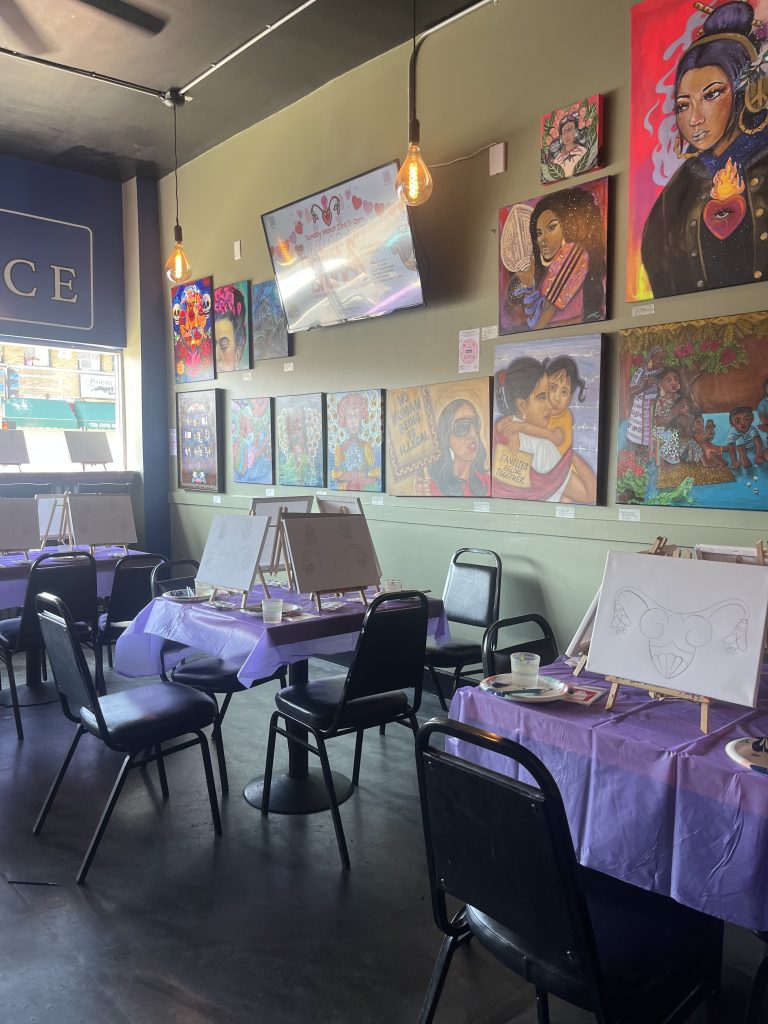
Ramirez also emphasizes the importance of being a community-based artist in Boyle Heights, saying, “I actually was born in Boyle Heights… I’ve had my studios here for over 20 years, and I’ve established myself as a Boyle Heights resident and also as a working artist here in Boyle Heights. So for me to have a space to curate and bring community together is very important, very vital for us and for us as a community, to have community run spaces and own spaces is very, very crucial for us.”
Distrito Catorce not only honors the Boyle Heights community, but sustainably fosters it and contributes to keeping it active and engaged. By using food as a means of togetherness, it pays homage to the distinct culture that fills Boyle Heights. “Food is always something that brings people together, community together,” Pinon says, looking around the restaurant in admiration. “That’s how I love to make sure that people are fed and taken care of and stuff like that…That’s why I do food distributions. Food’s a big thing in my life. I had a shortage of it when I was a kid. So to get into that kind of business and understand it, it’s rewarding for me.”
Boyle Heights is no stranger to gentrification, a process that pushes working-class people out of a neighborhood and often raises the costs of living. As reported by PBS SoCal, “In Boyle Heights, many residents see gentrification as a social, economic and cultural attack by WASPs against an overwhelming Latino community, despite the community’s history of ethnic diversity before WWII.” Defend Boyle Heights, which is now a part of the United Neighborhood Defense Movement, is an organization seeking to work against the powers of gentrification in the neighborhood.
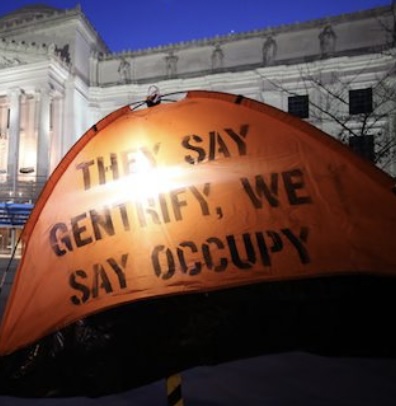
According to UCLA’s Urban Displacement Project, in 2018, LA County had 10% of its tracts exhibiting at risk of, ongoing, or advanced gentrification.
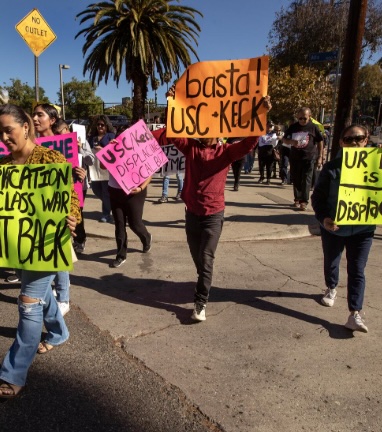
The UCLA Civil Rights Project found that over 50% of low socioeconomic neighborhoods in LA County were gentrified since 2000.
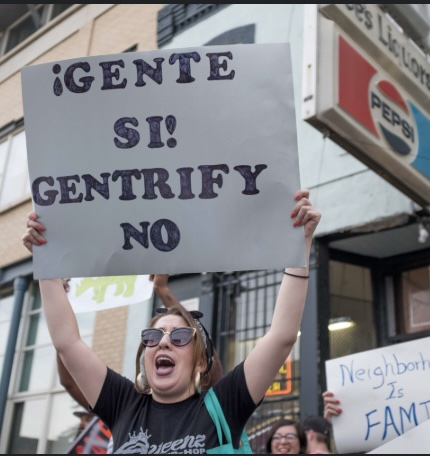
USC Sol Price researchers found that about 75% of Los Angeles residents spent more than 30% of their income on utilities and rent.
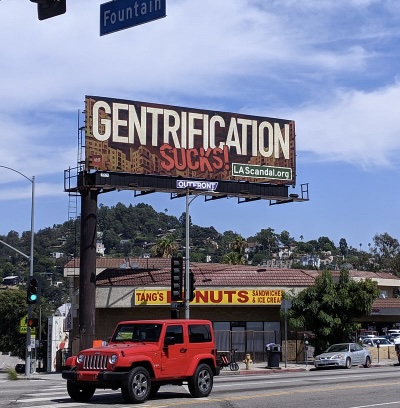
AP News found that between the years 2020 and 2022, LA’s homelessness population grew over 4%.
“We want to showcase that our food can be elevated, and it’s elevated for us, by us and for our community.” The community’s fight against gentrification continues, and it is powered by the civic engagement of its residents. In March 2024, the community saw a victory that stopped a large development project from being built by Tiao Properties. As reported by Fight Back! News, a five-and-a-half-hour-long community hearing ended at 10 PM when the East LA Planning Commission approved the appeal against the apartment building. “During public comment at the hearing, 40 community members – many of them Spanish speakers – testified about their firsthand experiences about evictions, displacement and homelessness,” states the article. “Three out of five of the planning commissioners were swayed by public testimony and also cited their own concerns about the scale and tone-deafness of the project.” However, an LA County Superior Court judge has recently ruled that the Planning Commission must reverse its appeal and approve the project following a lawsuit by Tiao Properties. This indicates that the fight against gentrification is ongoing for Boyle Heights and much of East Los Angeles.
Elly Schoen, the systems and data manager for Neighborhood Data for Social Change at the USC Lusk Center for Real Estate, discusses out how gentrification in Los Angeles County has pushed many residents out of their neighborhoods. “Something that we have found…LA County-wide, is that we’ve built about 115,000 new rental units over the last six years between 2018 and 2023. And 90% of those are affordable only to folks making above 120% of the area median income,” she points out. “So basically 90% of those housing units are market rate. So something that I’m really finding as we’re preparing this report is that we are doing some building, but we’re building essentially no affordable housing.”
The Neighborhood Data for Social Change website has an interactive map that showcases the amount of Ellis Act evictions in Los Angeles, with the opportunity to filter by neighborhood. “Ellis Act evictions are a specific type of eviction where basically the landlord is allowed to evict a tenant if they say that they’re going to go out of the rental business,” explains Schoen. “But usually what happens is that they either sell it to someone who puts it back on the market or they sort of renovate it and then put it back on the market.” Ellis Act evictions are a means of gentrification that pushes tenants out of their homes, but it is only one of many tools that pushes gentrification forward.
One of the keys to ensuring that the neighborhood remains true to its roots is creating establishments for the community by the community. And that is exactly what Pinon has done and will continue to do. Boyle Heights created Pinon’s commitment to community, and he has done his fair share of giving back. Although Distrito Catorce is committed to inclusion and cultural sensitivity, the issue of gentrification persists in the neighborhood. Perhaps that is why Distrito Catorce is more important now than ever– it gives residents a respite from the issues in their community and allows them to appreciate one another in a space created by one of their own.